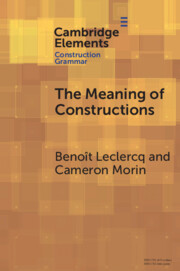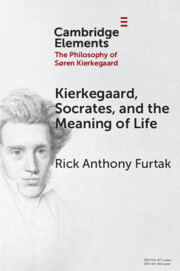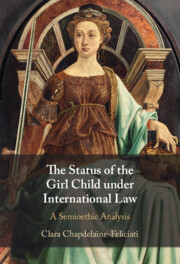Refine search
Actions for selected content:
237 results
14 - International Legitimacy as a System of Reference and Meaning
- from Part V - International Legitimacy and Change
-
- Book:
- The Law and Politics of International Legitimacy
- Published online:
- 14 July 2025
- Print publication:
- 24 July 2025, pp 259-282
-
- Chapter
- Export citation
Chapter 4 - Attachment Theory
- from Part I - The Beginnings of Meaning
-
- Book:
- The Development and Organization of Meaning
- Published online:
- 11 June 2025
- Print publication:
- 26 June 2025, pp 35-49
-
- Chapter
-
- You have access
- HTML
- Export citation
Chapter 5 - Toddlerhood
- from Part I - The Beginnings of Meaning
-
- Book:
- The Development and Organization of Meaning
- Published online:
- 11 June 2025
- Print publication:
- 26 June 2025, pp 50-64
-
- Chapter
-
- You have access
- HTML
- Export citation
Chapter 14 - Integration
- from Part V - Integration and Conclusion
-
- Book:
- The Development and Organization of Meaning
- Published online:
- 11 June 2025
- Print publication:
- 26 June 2025, pp 187-200
-
- Chapter
- Export citation
Chapter 3 - The Cradle of Meaning
- from Part I - The Beginnings of Meaning
-
- Book:
- The Development and Organization of Meaning
- Published online:
- 11 June 2025
- Print publication:
- 26 June 2025, pp 25-34
-
- Chapter
-
- You have access
- HTML
- Export citation
Chapter 11 - Competence, Resilience, and the Fate of Early Experience
- from Part III - The Organized and Organizing Nature of Meaning
-
- Book:
- The Development and Organization of Meaning
- Published online:
- 11 June 2025
- Print publication:
- 26 June 2025, pp 143-154
-
- Chapter
- Export citation
Chapter 13 - Trauma and Meaning
- from Part IV - Meaning and Disturbance
-
- Book:
- The Development and Organization of Meaning
- Published online:
- 11 June 2025
- Print publication:
- 26 June 2025, pp 175-184
-
- Chapter
- Export citation
Chapter 10 - The Role of Meaning in Intergenerational Transmission Effects
- from Part III - The Organized and Organizing Nature of Meaning
-
- Book:
- The Development and Organization of Meaning
- Published online:
- 11 June 2025
- Print publication:
- 26 June 2025, pp 128-142
-
- Chapter
- Export citation
Chapter 15 - Conclusion
- from Part V - Integration and Conclusion
-
- Book:
- The Development and Organization of Meaning
- Published online:
- 11 June 2025
- Print publication:
- 26 June 2025, pp 201-207
-
- Chapter
- Export citation
Chapter 1 - The Place of Meaning
- from Part I - The Beginnings of Meaning
-
- Book:
- The Development and Organization of Meaning
- Published online:
- 11 June 2025
- Print publication:
- 26 June 2025, pp 3-11
-
- Chapter
-
- You have access
- HTML
- Export citation
Chapter 9 - Meaning as the Currency of Development
- from Part III - The Organized and Organizing Nature of Meaning
-
- Book:
- The Development and Organization of Meaning
- Published online:
- 11 June 2025
- Print publication:
- 26 June 2025, pp 119-127
-
- Chapter
- Export citation

The Meaning of Constructions
-
- Published online:
- 16 May 2025
- Print publication:
- 22 May 2025
-
- Element
- Export citation
22 - Constitutional Interpretation
- from Part II - Modalities
-
-
- Book:
- The Cambridge Handbook of Constitutional Theory
- Published online:
- 27 March 2025
- Print publication:
- 24 April 2025, pp 361-377
-
- Chapter
- Export citation

Kierkegaard, Socrates, and the Meaning of Life
-
- Published online:
- 20 March 2025
- Print publication:
- 17 April 2025
-
- Element
- Export citation

The Status of the Girl Child under International Law
- A Semioethic Analysis
-
- Published online:
- 06 March 2025
- Print publication:
- 13 March 2025
Chapter 10 - One Career, Two Career Narratives
-
-
- Book:
- Pillars of Developmental Psychology
- Published online:
- 14 February 2025
- Print publication:
- 20 February 2025, pp 100-111
-
- Chapter
- Export citation
Chapter 16 - The Social, Cultural, and Racial Context of Development
-
-
- Book:
- Pillars of Developmental Psychology
- Published online:
- 14 February 2025
- Print publication:
- 20 February 2025, pp 170-182
-
- Chapter
- Export citation
2 - Philosophy of AI
- from Part I - AI, Ethics and Philosophy
-
-
- Book:
- The Cambridge Handbook of the Law, Ethics and Policy of Artificial Intelligence
- Published online:
- 06 February 2025
- Print publication:
- 13 February 2025, pp 40-58
-
- Chapter
-
- You have access
- Open access
- HTML
- Export citation
Meaningfulness, Conventions, and Rules
-
- Journal:
- Journal of the American Philosophical Association / Volume 11 / Issue 2 / June 2025
- Published online by Cambridge University Press:
- 10 January 2025, pp. 431-446
-
- Article
-
- You have access
- Open access
- HTML
- Export citation
Poetics and Performance: Fanfa Bands and the Semiotic Landscape in Northern Haiti
-
- Journal:
- Signs and Society / Volume 13 / Issue 2 / June 2025
- Published online by Cambridge University Press:
- 10 January 2025, pp. 123-135
-
- Article
-
- You have access
- Open access
- HTML
- Export citation
